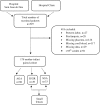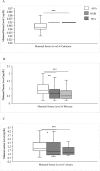Heavy metals exposure levels and their correlation with different clinical forms of fetal growth restriction
- PMID: 28985223
- PMCID: PMC5630121
- DOI: 10.1371/journal.pone.0185645
Heavy metals exposure levels and their correlation with different clinical forms of fetal growth restriction
Abstract
Background: Prenatal heavy metals exposure has shown a negative impact on birth weight. However, their influence on different clinical forms of fetal smallness was never assessed.
Objectives: To investigate whether there is a differential association between heavy metals exposure and fetal smallness subclassification into intrauterine growth restriction (IUGR) and small-for-gestational age (SGA).
Method: In this prospective case-control study, we included 178 mother-infant pairs; 96 of appropriate for gestational age (AGA) and 82 of small fetuses diagnosed in third trimester. The small ones were further subclassified into IUGR, n = 49 and SGA, n = 33. Cadmium (Cd), mercury (Hg), lead (Pb), arsenic (As) and zinc (Zn) levels were measured in the maternal and cord serum, and in the placentas of the three groups.
Results: Maternal serum level of Cd (p<0.001) was higher in the small fetuses compared to AGA. Fetal serum level of Cd (p<0.001) was increased in the small fetuses compared to AGA. Fetal serum level of Hg (p<0.05) showed an increase in SGA compared to both IUGR and AGA. Fetal serum level of Zn was increased in the AGA (p < 0.001) compared to each of the small fetuses groups. Only differences in the levels between the small fetuses' subgroups were detected in the fetal serum levels of Cd and Hg. Fetal birth weight was negatively correlated with the fetal serum level of Cd (p < 0.001). No differences in the placental heavy metal levels were observed among the groups.
Conclusion: Fetal serum levels of Cd showed differential correlation between small fetuses' clinical subclassification, which together with the increased Cd levels in both maternal and fetal serum of the small fetuses reinforce the negative influence of heavy metals on birth weight. These findings provide more opportunities to verify the role of heavy metals exposure in relation to small fetuses' subclassification.
Conflict of interest statement
Figures




Similar articles
-
Fetal exposure to toxic metals (mercury, cadmium, lead, and arsenic) via intrauterine blood transfusions.Pediatr Res. 2025 Feb;97(2):647-654. doi: 10.1038/s41390-024-03504-w. Epub 2024 Aug 30. Pediatr Res. 2025. PMID: 39215198 Free PMC article.
-
Birth outcome measures and maternal exposure to heavy metals (lead, cadmium and mercury) in Saudi Arabian population.Int J Hyg Environ Health. 2014 Mar;217(2-3):205-18. doi: 10.1016/j.ijheh.2013.04.009. Epub 2013 May 9. Int J Hyg Environ Health. 2014. PMID: 23735463
-
Placental 11B-Hydroxysteroid Dehydrogenase Type 2 mRNA Levels in Intrauterine Growth Restriction versus Small-for-Gestational-Age Fetuses.Fetal Diagn Ther. 2016;39(2):147-51. doi: 10.1159/000437139. Epub 2015 Aug 1. Fetal Diagn Ther. 2016. PMID: 26278975
-
Infant and mother related outcomes from exposure to metals with endocrine disrupting properties during pregnancy.Sci Total Environ. 2016 Nov 1;569-570:1022-1031. doi: 10.1016/j.scitotenv.2016.06.134. Epub 2016 Jul 2. Sci Total Environ. 2016. PMID: 27378155 Review.
-
Toxic metal (Cd, Hg, Mn, Pb) partition in the maternal/foetal unit: A systematic mini - review of recent epidemiological studies.Toxicol Lett. 2020 Oct 10;332:20-26. doi: 10.1016/j.toxlet.2020.06.007. Epub 2020 Jun 20. Toxicol Lett. 2020. PMID: 32569801
Cited by
-
It Takes Time to Unravel the Ecology of War in Gaza, Palestine: Long-Term Changes in Maternal, Newborn and Toddlers' Heavy Metal Loads, and Infant and Toddler Developmental Milestones in the Aftermath of the 2014 Military Attacks.Int J Environ Res Public Health. 2020 Sep 14;17(18):6698. doi: 10.3390/ijerph17186698. Int J Environ Res Public Health. 2020. PMID: 32938007 Free PMC article.
-
Association between placental toxic metal exposure and NICU Network Neurobehavioral Scales (NNNS) profiles in the Rhode Island Child Health Study (RICHS).Environ Res. 2022 Mar;204(Pt A):111939. doi: 10.1016/j.envres.2021.111939. Epub 2021 Aug 27. Environ Res. 2022. PMID: 34461121 Free PMC article.
-
Urinary trace metals in association with fetal ultrasound measures during pregnancy.Environ Epidemiol. 2020 Apr;4(2):e075. doi: 10.1097/ee9.0000000000000075. Environ Epidemiol. 2020. PMID: 32201854 Free PMC article.
-
The Role of Fe, Zn, and Cu in Pregnancy.Biomolecules. 2020 Aug 12;10(8):1176. doi: 10.3390/biom10081176. Biomolecules. 2020. PMID: 32806787 Free PMC article. Review.
-
Neonatal blood lead concentration predicts medium term lead-related outcomes in children ≤5 years old with congenital lead poisoning: A retrospective cohort study in Northern Nigeria.PLOS Glob Public Health. 2023 Mar 29;3(3):e0001644. doi: 10.1371/journal.pgph.0001644. eCollection 2023. PLOS Glob Public Health. 2023. PMID: 36989232 Free PMC article.
References
-
- Bernstein IM, Horbar JD, Badger GJ, Ohlsson A, Golan A. Morbidity and mortality among very-low-birth-weight neonates with intrauterine growth restriction. The Vermont Oxford Network. Am J Obstet Gynecol. 2000. January; 182(1 Pt 1):198–206. - PubMed
-
- Brodsky D, Christou H. Current concepts in intrauterine growth restriction. J Intensive Care Med. 2004. Nov-Dec; 19(6):307–19. doi: 10.1177/0885066604269663 - DOI - PubMed
-
- Hunt CE. Small for gestational age infants and sudden infant death syndrome: a confluence of complex conditions. Arch Dis Child Fetal Neonatal Ed. 2007. November; 92(6):F428–9. doi: 10.1136/adc.2006.112243 - DOI - PMC - PubMed
-
- Bamfo J K and Odibo AO. Diagnosis and Management of Fetal Growth Restriction. J Pregnancy. 2011; 2011: 640715 doi: 10.1155/2011/640715 - DOI - PMC - PubMed
-
- Markel TA, Engelstad H, and Poindexter BB. Predicting Disease Severity of Necrotizing Enterocolitis: How to Identify Infants for Future Novel Therapies. J Clin Neonatol. 2014. Jan-Mar; 3(1): 1–9. doi: 10.4103/2249-4847.128717 - DOI - PMC - PubMed
MeSH terms
Substances
LinkOut - more resources
Full Text Sources
Other Literature Sources
Medical
Research Materials
Miscellaneous

